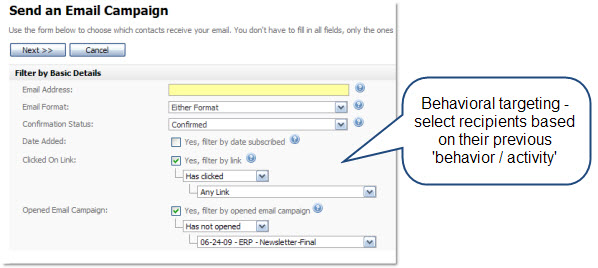Target Email Campaigns Based on Your Prospects Behavior and Interests
With Pinpointe, you can easily target your business email campaigns to contacts based on their actual, recent activities instead of relying only on static information like title, or state. For example, you can send emails to people who opened or clicked on campaigns about a specific topic. Or use Pinpointe’s Link tracking to see which users actually clicked on the embedded links within previous email campaigns on specific topics and use that behavioral information to select your recipients.
Here's a great example of how Pinpointe's behavioral targeting can improve email campaign response rates by up to 35%. Let's say you sent your monthly email newsletter to your list of prospects last week, and 20% of the recipients opened and viewed the email. With Pinpointe behavioral targeting, you can resend the campaign to only the people who did not open the campaign the first time around! This approach often results in an additional 25% – 35% of your recipients opening and reading your newsletter – all with a simple click.
If you’ve got a new product version coming out, why not send a special note to anyone who has specifically visited your website in the past 60 days?

Pinpointe’s flexible contact database also allows you to add a virtually unlimited number of fields for each list, and the custom fields can be used to capture additional details about prospects’ activities and specific interests. For example, say you want to learn more about your prospect’s desktop preferences: Mac or PC? Simply add the field to your Pinpointe website signup forms, and use the field to be sure your Mac customers don’t receive campaigns about PC offers.
Pinpointe can even do the work for you. You can set up automatic campaign responses that are triggered based on user activities. For example, say a prospect downloads a whitepaper on the topic ‘Virtual Security’ from your information library. Based on their behavior, an automat follow up message can be sent out a few days later, inviting the prospect to a local Virtualization trade show.
